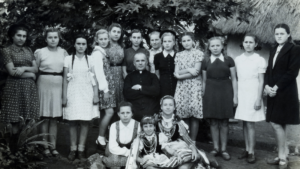When Europeans sought refuge in Africa
It’s a little-known piece of history that resonates in reverse today as European nations are closing their borders to African migrants.
But almost 80-years-ago, Africa provided a refuge for thousands of Europeans fleeing war, persecution and hunger.
 The seeds of this extraordinary exodus were sown in 1939 when Adolf Hitler and Joseph Stalin signed a nonaggression pact that divided several eastern European countries, including Poland, into German and Soviet spheres of interest.
The seeds of this extraordinary exodus were sown in 1939 when Adolf Hitler and Joseph Stalin signed a nonaggression pact that divided several eastern European countries, including Poland, into German and Soviet spheres of interest.
With a few days, Germany invaded Poland, triggering World War II.
Within a few weeks, the Soviets invaded Poland from the east. Like the Nazis in the west of the country, the Soviet Union began to carry out ethnic cleansing.
They deported hundreds of thousands of Poles, including many Jews, in four waves to forced labour camps in remote Russian regions such as Siberia and Kazakhstan.
In 1941, the tables were turned when Germany invaded the Soviet Union, forcing Russia to join the Allies.
It triggered an amnesty for the Poles in the USSR. Unable to return to war-torn Poland, some 116,000 Poles living in the Soviet Union were evacuated to Iran, which had been invaded by the Anglo-Soviet alliance.
But Iran proved unable to house and feed such large numbers of refugees, causing the British government to move Polish civilians to other British colonies.
It was by this circuitous route that the Polish deportees arrived in Tanzania, South Africa, Zimbabwe and other parts of British Africa to see out the rest of WWII.
Now a Canadian filmmaker is exploring the journey of his Polish ancestors in a documentary.
During WWII Jonathan Durand’s grandmother Kazia Gerech had lived in a refugee camp in what is present-day Tanzania and the stories of her childhood near the foot of Mount Kilimanjaro were seared into his memory.
“When your Polish grandmother says that she has gone on safari on Africa’s highest mountain, that inspires a child’s imagination,” he told a film festival this week.
As a history student, he was surprised about the lack of information about Poles seeking sanctuary in Africa — his professor had never heard of Polish refugee camps on the continent.
“That’s when I started my research,” Mr Durand said.
His grandmother’s stories about her life in the small town of Tengeru in northern Tanzania motivated him to embark on a nine-year odyssey that took him to Eastern Europe, the Middle East, and Africa.
The resulting film, ‘Memory is our Homeland’, won the Audience Award at the Montreal International Film Festival in 2019.
From 1942 to 1949, Ms Gerech lived with her siblings and parents in a simple thatched hut in Tengeru in what was then the British-administered territory of Tanganyika (now Tanzania).
During his travels to the former Polish refugee camps in South Africa, Tanzania and Zambia, Mr Durand said that local people “had good memories of the Poles,” who farmed and sent their children to school.
“It was often their first contact with whites,” he said.
The Polish refugees also have a positive memory of the locals, Mr Durand says.
“They were young, and these intercultural encounters have shaped their humanity.”
Historical documents from the time show the Poles and the locals were friendly and sometimes even celebrated mass together.
After the war, the Poles were reluctant to return to their homeland, which was under Soviet control. Eventually, they migrated mostly to Australia, Canada, and Great Britain.
Mr Durand’s grandmother made it to England in 1949. There she met her husband, a Pole and a survivor of the Majdanek concentration camp. Together, they immigrated to Canada.
Watch a trailer of the film: https://memoryisourhomeland.com/.












